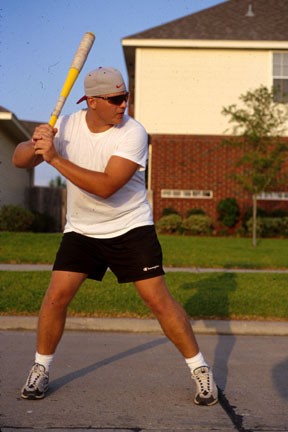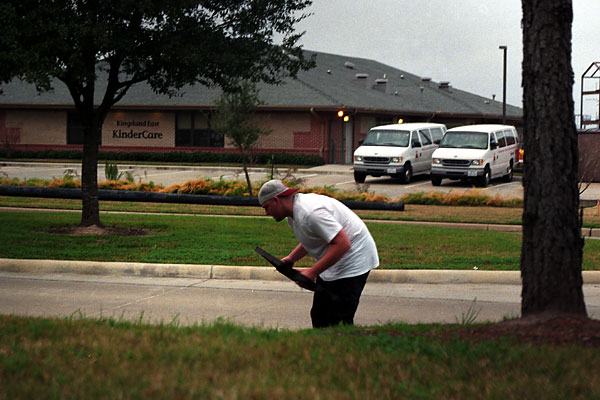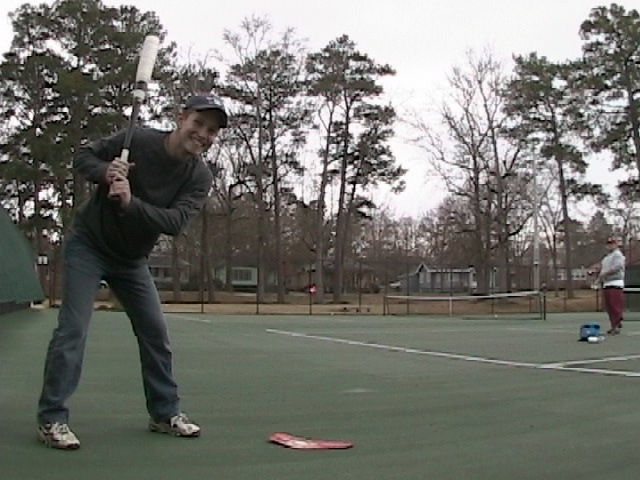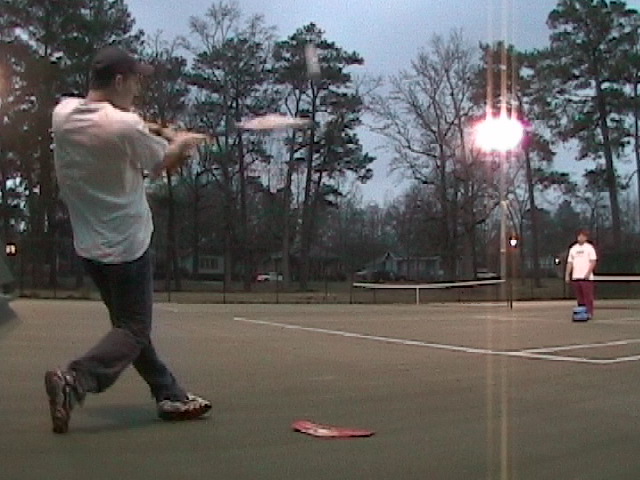History
 One warm, muggy evening in the summer of 1994, Jeff and Jon walked out into the street with a plastic bat in one hand and a whiffle ball in the other. We stood behind a line of tar on the road and took turns trying to hit the ball over a light pole. And it was fun. A few nights later, Jeff introduced Rob to his new game. It was addicting, as the quick swings, loud thwacks, and majestic carry of the ball over a light pole gave the illusion that we could all really hit the crap out of a ball.
One warm, muggy evening in the summer of 1994, Jeff and Jon walked out into the street with a plastic bat in one hand and a whiffle ball in the other. We stood behind a line of tar on the road and took turns trying to hit the ball over a light pole. And it was fun. A few nights later, Jeff introduced Rob to his new game. It was addicting, as the quick swings, loud thwacks, and majestic carry of the ball over a light pole gave the illusion that we could all really hit the crap out of a ball.
We tried the game with a variety of plastic balls. With our mighty swings, we found that hollow plastic balls with holes cracked and tore, and efforts taping them to prolong their life were unsuccessful. Other kinds of hollow, solid balls we tested would become permanently dented and unusable after just a few hits. Over time, after experimenting with almost every kind of plastic ball, we found that ATEC solid hollow practice balls (6-pack part #BB04580, 12-pack part #BB01407) or P&L Sports (later becoming Omni Sports Technologies and then Axiom Sports) "smooth polyballs" were the perfect choice.
We also discovered that wrapping tape around the barrel of our bats would add weight and hardness, allowing us to hit the balls a lot harder and farther. After much experimentation, we found that standard athletic tape or heavier electrical tape was the most effective choice. As time went on, we chose tape in a variety of colors to add personal flair to each of our bats.
 We soon began to lay out the basic rules for our new game, Home Run Derby, modelling it after the MLB Home Run Derby. Any swing that was not a home run would be an out. While 10 outs in a round was the standard for the MLB Home Run Derby at the time, our first games used 5 outs in a round. Any round ending in a tie would lead to a "hit-off" tiebreaker round of 3 outs. After a while, everyone agreed that the 5-out rounds went too quickly and that 3-out hit-offs were too long, so we decided to adopt the MLB standard of 10-out rounds and reduce hit-offs to 2 outs. With the basic rules in place, we started keeping detailed statistics and personal streak and distance records.
We soon began to lay out the basic rules for our new game, Home Run Derby, modelling it after the MLB Home Run Derby. Any swing that was not a home run would be an out. While 10 outs in a round was the standard for the MLB Home Run Derby at the time, our first games used 5 outs in a round. Any round ending in a tie would lead to a "hit-off" tiebreaker round of 3 outs. After a while, everyone agreed that the 5-out rounds went too quickly and that 3-out hit-offs were too long, so we decided to adopt the MLB standard of 10-out rounds and reduce hit-offs to 2 outs. With the basic rules in place, we started keeping detailed statistics and personal streak and distance records.

We played whenever we could. The Texas heat and passing cars made it difficult to play Home Run Derby during the day, and Rob and Jeff found that playing very late at night was a lot more fun. On the street, we kept losing balls down the storm drains along the curb. After repeatedly climbing down into them with a flashlight to retrieve lost balls, we discovered that covering them with some scrap wood to prevent them from rolling in was much easier.
 As the game progressed, Jeff and Rob played at different parks and experimented with goofy rules to accommodate quirky situations. One rule that made things a lot more interesting was that a ball caught in the air by the pitcher counted as 2 outs for the hitter. At one point, hitting a ball into the pitching bucket counted for a home run, hitting the roof of the house across the street counted for 2 home runs, and a home run through the open front door of a house under construction counted for 10 home runs (Mitch was the only one to do this).
As the game progressed, Jeff and Rob played at different parks and experimented with goofy rules to accommodate quirky situations. One rule that made things a lot more interesting was that a ball caught in the air by the pitcher counted as 2 outs for the hitter. At one point, hitting a ball into the pitching bucket counted for a home run, hitting the roof of the house across the street counted for 2 home runs, and a home run through the open front door of a house under construction counted for 10 home runs (Mitch was the only one to do this).
Eventually, Jeff and Rob found that the game was best played on a double tennis court. A fence would eliminate judgement calls, and there would be no passing cars to interrupt the game or sneaky neighbors to steal our balls. From that point on, the hunt was on every night for the perfect tennis court: one that was available to the public, one that had no trees or roofs or drains to swallow up our balls, and one that was not being used by annoying people who actually wanted to play tennis.
 After being forced to use a variety of plastic balls over the years, some of which were "juiced" and tainted many of our long-standing records, we have found that the most widely available ball that plays much like our original balls is the
Blitzball. It has become the new ball of choice for Home Run Derby.
After being forced to use a variety of plastic balls over the years, some of which were "juiced" and tainted many of our long-standing records, we have found that the most widely available ball that plays much like our original balls is the
Blitzball. It has become the new ball of choice for Home Run Derby.
Changing equipment and flunctuating home run totals over the years have rendered many of our original records useless. As a result, we decided to scrap home run numbers as a meaningful statistic and instead focus on wins and strength of competition as the metrics to rate player performance. Check out the stats page to see who's on top.
It's been 30 years since we first began swinging for the light pole in the summer of 1994. Some players have gone, but a new generation of young players has arrived to carry the game forward. Enjoy!
Timeline
The history of the game with all the dates we can remember.
|
Summer
1991
|
Jeff and his Dad play Nerf baseball in the backyard of their Montreal apartment. In need of a proper strike zone, Jeff fashions a home plate out of an old Nike shoebox, red marker, and some plastic tape. The plate is still used for Home Run Derby today. |
|
May
1994
|
Jeff and Rob finish unspectacular high school baseball careers. |
|
Jun
1994
|
On a boring summer evening, Jeff and Jon take some swings with a plastic bat in front of Jeff's house. We decide to make a game out of it, modelling the Major League version of Home Run Derby. Any ball traveling over an imaginary line from the top of the light pole is a home run. Rob and Jeff play for the first time, with rules that establish 5 out rounds and 3 out hit-offs. We use a single ball, retrieving it after every hit. We stay up until 3am and complete 38 rounds, anally keeping stats of home run totals and streaks on a piece of scratch paper. We also keep track of where the longest home runs land. Jeff begins to keep the Home Run Derby stats on his computer, setting up a simple Excel spreadsheet to record the totals. |
|
Jul
1994
|
To preserve the end of a plastic bat that was beginning to crack, Rob and Jeff apply several layers of plastic tape to it, extending the tape down the length of the barrel to make it more balanced. The increased weight and stiffness of the taped bats began to dent and crack the plastic balls. The balls with holes in them prove to be especially fragile. Rob and Jeff begin to play Home Run Derby using multiple balls, reducing the amount of time spent shagging (balls, not each other). We experiment with different types of balls, but none of them are able to withstand the abuse of our taped bats. In an effort to preserve the plastic balls, Rob and Jeff begin to tape them with athletic tape. They would still crack, but successive layers of tape would extend their lives. Without access to the standard equipment, Rob and Robbie play Home Run Derby in Rob's backyard, using broomsticks and his house as the leftfield wall. |
|
Aug
1994
|
Rob discovers ATEC smooth polyballs at Academy. They prove to be the first balls which are unbreakable in Home Run Derby and are quickly adopted as the standard Home Run Derby ball. Unfortunately, Rob only purchases a package of six, and we would lose most of them down storm drains and in out neighbors' backyards. We have a hard time finding the balls again for the rest of the summer. Rick, Jon's father, takes one swing and hits a home run over the light pole. Because he declines to finish the round, his stats are not officially recorded. Lauren, Jon's sister, takes a few swings and becomes the first girl to play. She also does not complete the round, so her stats are also not officially recorded. Jeff finally realizes that putting boards in front of the storm drains will reduce the number of times we have to chase rolling balls or climb into the sewer to retrieve lost balls. Rob shows up to play Home Run Derby one day with batting gloves and yellow shooting glasses. Jeff and Mitch laugh at him. |
|
Dec
1994
|
Rob and Jeff meet up over the holidays to play Home Run Derby. The cooler weather does not dampen their enthusiasm for the game. |
|
May
1995
|
Home again from college, Rob and Jeff desperately search for more smooth polyballs. While visiting a local Target, We run into their old high school baseball coach. An awkward conversation ensues. Rob and Jeff are reminded of the little dollops of spit that collect on the corners of his mouth when he talks. |
|
Jun
1995
|
In a rare display of artistic flair, Mitch creates a bat with several layers of red, white, and blue tape on the barrel. On a hot summer day, the excessively taped bat melts on the sidewalk before it is even used. Mitch's interest in Home Run Derby dwindles. Jon shows some initiative and orders a box of smooth polyballs directly from ATEC. He then bitches for months until the rest of us pay for our fair share. |
|
Jul
1995
|
After several of our smooth polyballs disappear, Jon accuses our neighbor of stealing them for his kids. In return, our neighbor bitches at Jon. Jon and Jeff begin decorating their balls with a marker to personalize them. Our neighbors complain to us about the noise level at night. We also express their displeasure with our home runs pelting their house. As a result, Rob and Jeff start looking for new places to play Home Run Derby. To avoind conflict with the neighbor, Rob and Jeff begin playing on Norwalk Drive, an adjoining street surrounded by open field and houses under construction. The same rules are used, but the dimensions and wind patterns of the new location change the game dramatically. |
|
Apr
1996
|
Rob and some fraternity brothers play Home Run Derby at the Fiji house at Florida State University. Balls rain down on the Pi Phi house. For the first time, rounds are played with 10 outs and balls hit over a wall are counted as home runs. Rob sets an unofficial record after hitting 14 home runs in a round. |
|
Jul
1996
|
While playing on Norwalk Drive, Jon swings and nearly shatters a neighbor's window after letting go of the bat. The search for better locations to play Home Run Derby continues. |
|
Aug 2
1996
|
Mike K. uses Jon's camera to capture video footage of Home Run Derby on Norwalk Drive. Jeff produces a comlpetely horrible, unwatchable video with the footage. |
|
Mar
1997
|
While on Spring Break in the Bahamas, Jeff and Rob consider playing Home Run Derby on the beach, but the ocean breeze makes it impractical. |
|
Jun
1997
|
Home Run Derby rules are modified to extend the rounds, reduce shagging time, and heighten the drama of hit-offs. Rounds are expanded from 5 outs to 10 and hit-offs are reduced from 3 outs to 2. After an extended absence, Mitch returns to play with us on Norwalk Drive. To make things interesting, we decide that a fly ball landing in the bucket counts for 2 home runs, a ball going through the front door of a nearby house under construction counts for 2 home runs, and a ball hitting the roof of the house counts for 10 home runs. |
|
Dec
1997
|
Rob suggests playing Home Run Derby on tennis courts with fences to eliminate judgement calls. After finding a lighted tennis court with a left field wall and a partial right field fence, Rob and Jeff establish that any ball landing beyond the court is a home run. Jeff had a difficult time adjusting to the new surroundings and hated it. These tennis courts marked the first time Rob and Jeff played somewhere other than on a street. |
|
Jan 25
1998
|
Jeff's computer crashes. All of our accumulated stats up to this point are lost. We start from scratch. |
|
Mar
1998
|
While away at college and missing the game he loves, Jeff creates a the first Home Run Derby web site, a basic page with pictures and captions. Rob and Colin play Home Run Derby on a softball field with plastic golf whiffleballs. A fly ball past the infield dirt counts as a home run. Jeff and his college roommates play Home Run Derby in a small parking lot near the campus of the Univeristy of Southern California. |
|
May 2
1998
|
Rob and Jeff, now college graduates, return to Norwalk Drive to play Home Run Derby. The earliest surviving Home Run Derby statistics are recorded. Rob establishes an official single round record of 12. |
|
Dec 27
1998
|
Rob and Jeff test Home Run Derby on a local tennis court surrounded on all sides by a chain link fence. We decide that standing on one corner of two side-by-side tennis courts makes a reasonably sized park (see the diagrams of our current parks). The experiment is a resounding success and would change the game of Home Run Derby forever. |
|
Sep 14
1999
|
Rob hits 20 home runs to break his own single round record. |
|
Oct
1999
|
While playing on the tennis courts, Rob and Jeff are confronted by a police officer who thinks that we are causing trouble. We ask him to play a round with us, but he declines. |
|
Oct 5
1999
|
Rob hits 21 but gets screwed when the lights go out and the entire round is voided. The current rules, which would have preserved the stats, are not yet in place. |
|
Dec 19
1999
|
Rob hits 23 to break his own single round record. This record would stand for over 3 years. |
|
Jul
2002
|
Jeff experiments with a Little League aluminum bat. It feels good, but the balls don't carry. Jeff returns the bat to Academy the next day. |
|
Jul 16
2002
|
Rob sustains the first official Home Run Derby injury (strained patella tendon) after swinging out of his shoes. |
|
Jun 6
2003
|
Rob and Jeff purchase new plastic bats and wrap them with tape. They prove to be more powerful than all of their previous bats. With his new "juiced" bat and some new "juiced" balls mixed in, Jeff breaks the long-standing single round home run record with a round of 26. Rob and Jeff start to question the impact of this new equipment on the game. |
|
Jun 24
2003
|
Rob and Jeff attempt Home Run Derby at a gymnasium, playing inside for the first time. A new batch of smooth polyballs seems harder and heavier than the old balls we used to play with. After a few practice swings, the delicate foam gymnasium roof has several holes in it. |
|
Feb 20
2004
|
Rob sets up his video camera on a tripod to record Home Run Derby from several different angles. A few minutes later, a local photographer wanders by and starts taking pictures for his company newspaper. Connie becomes the first girl to play a full round of Home Run Derby. Needing just 1 home run to tie Jeff and reach 1000 for his career, Rob ends a round with six consecutive outs and violently flings his bat in disgust. After years of anticipation, Rob finally hits his 1000th career home run in an anticlimactic losing round of 2. Jeff hits 28 home runs to break his own single round record. |
|
Oct 10
2004
|
While driving from Houston to Atlanta, Jeff and Rob chronicle the ten year history of Home Run Derby. The history of the game is now preserved for future generations. |
|
Oct 23
2004
|
Due to the gaudy numbers we are putting up with "juiced" balls and bats, Rob and Jeff consider a permanent switch to metal bats in Home Run Derby to keep the numbers down. |
|
Oct 25
2004
|
Jeff redesigns the Home Run Derby website, adding advanced statistics and player profiles. Nerdtastic. |
|
Jan 17
2005
|
Corky convinces Jeff to play in 17° F weather. The stiff breeze in from left makes it feel like 1°. It snows for a few moments. The weather is so cold that 5 of the plastic balls explode into pieces when we hit them. |
|
Jan 21
2005
|
Using almost entirely "juiced" balls, Jeff goes nuts and hits 47 home runs, setting a new single round record. Serious thought is given to using real baseball bats to lower the numbers back to "normal" levels. |
|
Jan 29
2005
|
In town for the HOFL Annual Draft, Jeff and Corky introduce ten other owners to Home Run Derby. In heavy snowfall, Josh (Seattle) surprises everyone with his big stick and Frank (Mudville) cracks his head on the slippery ice. |
|
Jun 17
2005
|
Jeff revolutionizes stat-keeping for Home Run Derby. Organizing the data makes it possible to make an online database of Home Run Derby statistics. |
|
Jul 12
2020
|
After many years away from Home Run Derby, Jeff, Rob, Mitch, and our kids reunite for Home Run Derby. Blitzballs prove to be perfect for the game, playing very much like the original smooth polyballs that are no longer available. With the rediscovery of Home Run Derby, Jeff rebuilds the Home Run Derby website from the ground up. Added are live scoring functionality, dynamic statistics, and history updates. |
